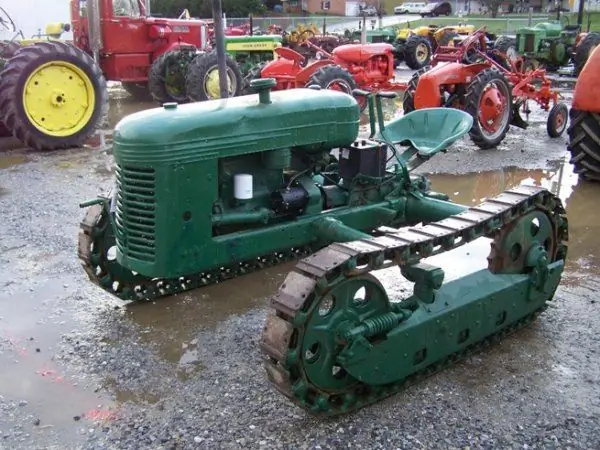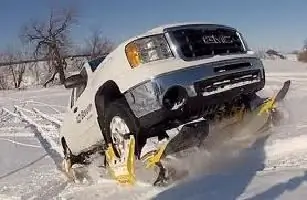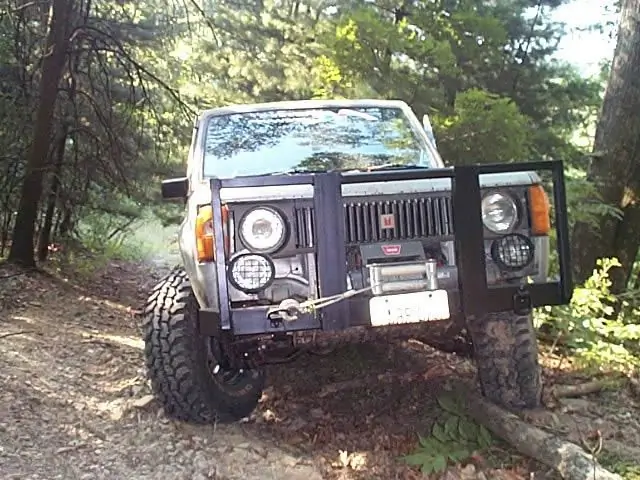2025 Author: Erin Ralphs | [email protected]. Last modified: 2025-01-22 21:14:14
The territory of the former USSR occupied one sixth of the land, which means that it was not possible to build good roads in all its corners. The undeveloped expanses of the Far North, taiga trails, the swampy plains of Tyumen, the endless steppes of the middle zone - all these are places that become impassable in the autumn-winter period. There are no roads, only directions. Traditionally, caterpillar vehicles or aircraft were used to move through difficult areas.

For residents of remote villages, it is not at all accidental that they are interested in any technique that can overcome impassability. True, the automotive industry had little to offer, especially if a small all-terrain vehicle was required, economical and also inexpensive. Theoretically, it is possible to purchase imported, but hardly a simple ruralresidents can afford it. The only way is to invent and build the desired machine yourself - from improvised means. This is how home-made all-terrain vehicles are made, based on the possibilities and using all available parts. And our people never complained about the lack of ingenuity.
Invention Story
The bulk of all kinds of all-terrain vehicles appeared in the post-war period. All-terrain vehicles were made on caterpillar tracks, ski-caterpillar, but the models of all-terrain vehicles on pneumatics (large-diameter wheels with internal pressure up to half the atmosphere) turned out to be the most promising. Such wheels allowed the car not to fall into snowdrifts, move confidently on eroded clay soils and even overcome swampy terrain.

One of the first "home" all-terrain vehicles was a karakat - a motorcycle put on tires from a truck. Home-made all-terrain vehicles, assembled by craftsmen in the north of our country, were very convenient for winter fishing, since they easily overcame snow drifts, and when they landed in a wormwood, they did not sink. In order for the camera not to look like a donut when inflated, it was surrounded by belts, which, by the way, became excellent lugs, preventing slippage. However, it was necessary to warm up thoroughly for a trip on such a “miracle”. Therefore, many further developments were assembled on the basis of bodies from cars or UAZs.
By the way, American and Canadian designers also conducted similar developments. For example, an all-terrain vehicle on pneumatic scooters with an original engine was offered by the AmericanLockheed company. Instead of wheels, this model has three pneumatic scooters, for which radial brackets with a connection angle of 120 degrees were used.

Design differences of all-terrain vehicles
Wheel homemade all-terrain vehicles can have one axle (three-wheeled), with a 4 x 4 scheme - two, and with a 6 x 6 scheme - three. 8 x 8 patterns are found on American and Canadian ATVs.
One of the design features of pneumoscooters is an articulated frame. This design makes it possible for each wheel to take its position regardless of the neighboring one at different angles (within acceptable limits). Such a frame is called "breaking" and performs two functions: it increases the cross-country ability and reduces the likelihood of the all-terrain vehicle overturning or tipping over. Such frames can be welded from corners, channels, pipes of various sizes and sections.
Home-made all-terrain vehicles of large and medium sizes are usually equipped with diesel engines, and carbureted ones are more often used on pneumatic scooters for individual purposes - trips to the forest, fishing and hunting.

Homemade all-terrain vehicles on low-pressure tires
Whatever technique was used by self-taught craftsmen to create all-terrain vehicles: motorcycles, boats, mopeds, trucks, cars and even broken tractors. The most unpretentious design consists of a walk-behind tractor, a homemade frame and low-pressure tires tied with belts. For three-wheeled models, the main disadvantage isconsider the lack of all-wheel drive.
The creation of such an all-terrain vehicle does not require many complex parts, it is easier to assemble and lighter in weight, and the engine from a walk-behind tractor, mower or motorcycle is much cheaper than a car. Since the level of driver comfort on a frame without a cab is zero, most often they install a self-welded cab, which is either insulated or a heater is installed.
An excellent example of design thought is the brainchild of the St. Petersburg engineer A. Gargashyan - the all-terrain vehicle "Cheburator". The designer equipped his first model with an engine from the Oka, a box from the Niva, and UAZ bridges were used. Such a hybrid on the primer could move at speeds up to 60 kilometers and move 300 kilograms of cargo. The all-terrain vehicle was tested off-road of varying difficulty and showed good results.
Where to start?
First of all, you need to decide what you need an all-terrain vehicle for and what type (caterpillar or pneumatic scooter) you prefer. After all, the flight of creative thought can be limited not only by the availability of suitable parts, but also by experience with various mechanisms. The next step in creating the concept of a future car is making a decision about operating conditions, carrying capacity and, of course, capacity (how many people can ride it). Knowing the initial requirements, you can start creating a diagram with the layout and placement of all components and assemblies, planning places for the driver and passengers, as well as the cargo compartment. If it is possible to use Internet resources, then you should look at the relevant forums wherehomemade masters post photos, diagrams, share problems and experiences.

How to choose an engine?
Not every engine is suitable for installation on homemade all-terrain vehicles, since the main requirement is forced cooling. If a motorcycle engine is used, then a special casing is required, which will provide a constant flow of air. Secondly, you need a motor with a power reserve in case of extreme situations. Year-round operation is more suited to four-stroke engines, which are easier to start in extreme cold.
With the increase in the number of Chinese equipment on our market, engines from Chinese-made walk-behind tractors under Japanese licenses were used. These units are unpretentious, reliable and have a reasonable price and sufficient power.
Where to register homemade?
Homemade vehicles should be registered with Gostekhnadzor, which has no right to refuse such registration if there is a Certificate of Conformity.
The certification procedure is as follows. The first step is to write the specifications for the manufactured home-made vehicle. The second is an appeal to the local certification body, which sends the inventor (and his product) for certification tests. The third is to pass tests and receive a Certificate of Conformity, with which to go to Gostekhnadzor.
Gostekhnadzor must register a homemade product and issue a passport of a self-propelled machine (PSM), according to which it is registered with the authoritiestraffic police. Good luck!
Recommended:
Homemade caterpillar minitractor: features and photos

Homemade caterpillar minitractor: specifications, assembly recommendations, features, photos, operation. Do-it-yourself homemade caterpillar minitractor: frame, engine, other elements, advantages and disadvantages
Off-road vehicles: an overview of the world's best off-road vehicles

Off-road vehicles: review, specifications, photos, features. cross-country vehicles: a list of foreign and domestic modifications. What are the cars with improved cross-country ability in the GAZ line?
How to assemble a homemade moped from improvised materials?

Today trade offers a large number of scooter models from various manufacturers. A person who wants to buy a vehicle has a huge choice. However, even with such an abundance of options, not everyone finds what he likes
What is a homemade caterpillar?

Russia is famous for its craftsmen who are able not only to repair a car with their own hands, but also to develop and manufacture home-made tracked vehicles
Homemade winch: diagram and detailed description

The winch is one of the most essential tools that every off-road conqueror should have. Indeed, without this mechanism, it will be almost impossible to pull your car out of a ditch or ford. Some motorists purchase ready-made winches and put them on power bumpers, while others make them with their own hands. And if you are in doubt about choosing the right tool, you can try to make it yourself. Our today's article will help you with this

